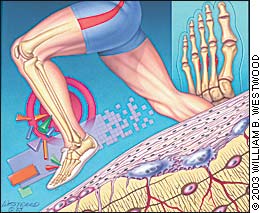
Am Fam Physician. 2003;68(8):1467

On page 1595 of this issue, you will find the first in a new series of short drug updates called “STEPS.” This acronym stands for the key components of the update: Safety, Tolerability, Effectiveness, Price and Simplicity. The series is coordinated by Allen F. Shaughnessy, Pharm.D., who is director of medical education at Pinnacle Health System, Harrisburg, Pa., and one of AFP's contributing medical editors. The article in this issue, “Ezetimibe for Hypercholesterolemia,” is written by Spencer Morris, Pharm.D., and Rob Tiller, M.D., Greenwood (S.C.) Family Practice Residency. If you have been wondering whether ezetimibe (Zetia) is right for your patients, you will probably appreciate their succinct review, which concludes with this bottom-line recommendation:
“Ezetimibe is safe and effective for lowering LDL cholesterol and triglyceride levels but has not been shown to affect patient-oriented outcomes. It can be used as monotherapy or in combination with a low-dose statin, although the combination is more expensive than the maximum dose of the statin. Ezetimibe is reasonable adjunct therapy for patients who have not reached LDL goals on maximum statin dosage or who cannot tolerate maximum doses of statins. Ezetimibe also is an acceptable treatment option for patients with hyperlipidemia who are intolerant of statins, as long as they understand that there is no proven benefit regarding clinical outcomes.”
These short reviews will appear once or twice a month and will offer physicians snapshots of new drugs that they may be considering for their armamentarium of drug choices. Upcoming topics include atomoxetine (Strattera), desloratidine (Clarinex), escitalopram (Lexapro), tiotropium (Spiriva), teriparatide (Forteo), adefovir (Hepsera), telithromycin (Ketek), tegaserod (Zelnorm), and eplerenone (Inspra).
The safety section, Dr. Shaughnessy points out, will include a summary of the known side effects of the drug. However, the safety profiles of new drugs are not as clear as those of older, more established medications. When safety is an issue for a patient, the physician may wish to postpone trying it for the first year or so after release to benefit from accumulating safety data.
The section on tolerability will focus on the less serious adverse effects of the drug, such as drowsiness or insomnia. When comparing tolerability of various drugs, Dr. Shaughnessy suggests evaluating “pooled dropout rates,” or the percentage of patients who stop taking a drug during clinical trials.
The discussion on effectiveness will include a comparison of the new drug against the drugs in current use, with an emphasis on patient-oriented outcomes rather than physiologic or disease-oriented end points. Data directly comparing the effectiveness of therapy may not be available at the time a drug is first marketed.
Price issues, also a point of discussion in STEPS, can be complex, according to Dr. Shaughnessy. Added benefits and simplicity of a treatment and the extra cost of additional monitoring, if necessary, must be weighed when considering the cost equation. Simplicity of treatment may be better with a new drug, in terms of dosage, administration, handling, or side effects, but it may not always offset the cost.